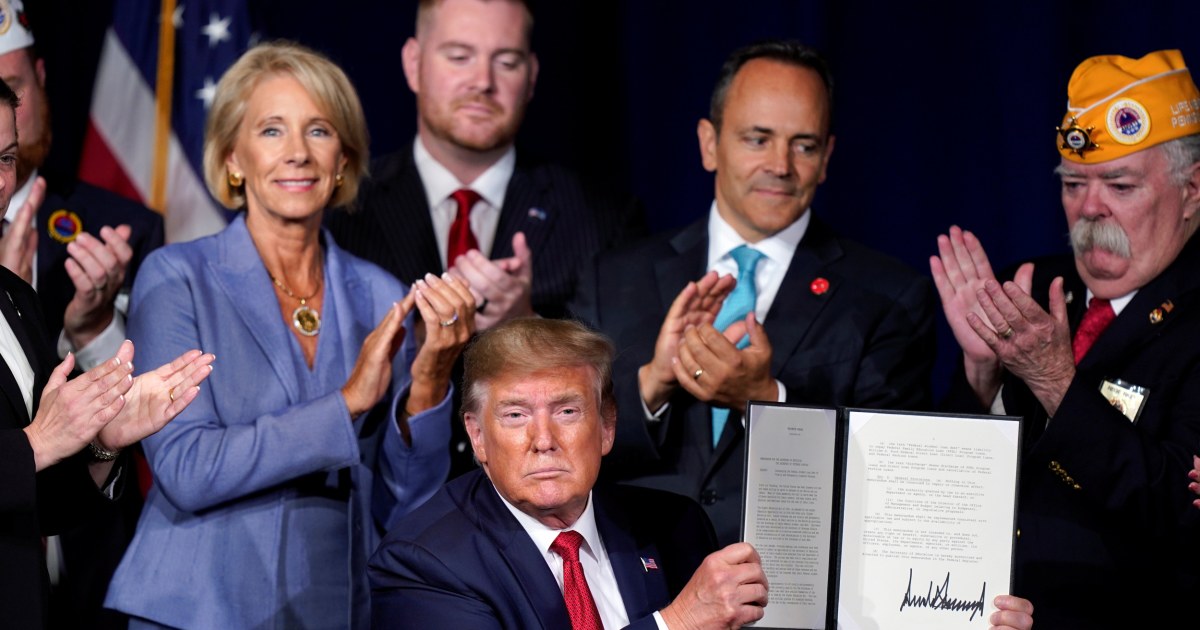The Trump Administration And Black Student Loan Debt

Table of Contents
Key Policies of the Trump Administration Regarding Student Loans
The Trump administration implemented several policies impacting student loan borrowers. While not explicitly targeting racial disparities, their consequences significantly affected Black communities grappling with higher rates of student loan debt.
Changes to Income-Driven Repayment (IDR) Plans
The Trump administration made few direct changes to Income-Driven Repayment (IDR) plans. However, the overall emphasis on fiscal conservatism and budget cuts potentially impacted the effectiveness of existing IDR programs for Black borrowers.
- Limited Funding for Outreach and Support: Reduced funding for student loan counseling and outreach programs may have disproportionately affected Black borrowers who often face greater challenges navigating complex repayment options.
- Increased Scrutiny of Eligibility: While no direct changes were made to eligibility criteria, the administration's focus on reducing government spending could have led to stricter enforcement of existing rules, potentially excluding some Black borrowers from IDR plans.
- Impact on Repayment Amounts: Although IDR plans themselves weren't significantly altered, the lack of broader initiatives to address underlying racial disparities in income and employment opportunities likely meant that many Black borrowers continued to face substantial repayment burdens.
Focus on Vocational Training and Alternative Education Paths
The Trump administration promoted vocational training and alternative education pathways as a means to reduce the reliance on traditional four-year colleges, thereby potentially lowering student loan debt.
- Expansion of Apprenticeships and Skills Training: The administration championed initiatives promoting apprenticeships and skills-based training programs. While potentially beneficial, access to these programs and their effectiveness in addressing racial disparities requires further investigation. Did these programs effectively reach and support Black communities, or did existing systemic inequities hinder their success?
- Limited Focus on Equitable Access: The success of vocational training in alleviating student loan debt for Black borrowers hinges on equitable access to these programs. Were these initiatives adequately funded and marketed in communities where Black students are disproportionately represented?
- Earnings Potential and Debt Reduction: The effectiveness of vocational training in reducing overall debt depends on whether these programs lead to comparable or higher earnings compared to traditional college degrees. This aspect requires further study, particularly concerning the outcomes for Black graduates.
Approaches to Student Loan Forgiveness Programs
The Trump administration showed little appetite for widespread student loan forgiveness programs. This stance had significant implications for Black borrowers who often carry higher loan balances and face greater repayment challenges.
- Limited Expansion of Existing Programs: The administration did not expand or create new forgiveness programs, leaving existing programs largely unchanged. This lack of action perpetuated existing inequalities in access to debt relief.
- Emphasis on Personal Responsibility: The administration often emphasized individual responsibility for debt repayment, potentially overlooking systemic factors contributing to racial disparities in student loan debt.
- Impact on the Racial Wealth Gap: The lack of loan forgiveness initiatives under the Trump administration likely exacerbated the racial wealth gap, as Black borrowers continued to struggle with significant debt burdens, impacting their ability to accumulate wealth.
Analyzing the Impact on Black Borrowers
The Trump administration's policies, or lack thereof, regarding student loan debt had significant implications for Black borrowers.
Disparities in Loan Amounts and Repayment Challenges
Black students often borrow more for college than their white counterparts due to various socioeconomic factors. The Trump administration's policies did little to directly address this existing disparity.
- Higher Initial Debt Burden: Black borrowers often enter repayment with significantly higher loan balances, making repayment more difficult.
- Lower Earnings Potential: Black graduates often face lower earning potential compared to white graduates, making loan repayment more challenging.
- Data Gaps and Lack of Targeted Solutions: The absence of targeted data collection and analysis on the racial impact of student loan policies made it difficult to assess the full extent of the challenges faced by Black borrowers.
Access to Resources and Support
Access to resources and support for student loan repayment is crucial, but systemic inequities often hinder Black borrowers' access to these services.
- Limited Financial Literacy Programs: Access to financial literacy programs tailored to the specific needs of Black borrowers may have been limited.
- Lack of Culturally Competent Counseling: Many student loan counseling services lacked cultural competency, making it difficult for Black borrowers to connect with and receive effective support.
- Systemic Barriers to Navigation: Navigating the complex student loan system can be challenging for anyone, but systemic barriers and lack of support made it even harder for Black borrowers.
Long-Term Financial Consequences for Black Communities
The long-term financial consequences of student loan debt for Black communities are profound, affecting homeownership, wealth accumulation, and intergenerational wealth transfer.
- Delayed Homeownership: High student loan debt can delay or prevent Black individuals from purchasing homes, impacting their ability to build wealth.
- Reduced Savings and Investment: Significant student loan payments can limit savings and investment opportunities, hindering wealth accumulation.
- Intergenerational Impact: The burden of student loan debt can impact future generations within Black families, perpetuating economic inequality.
Conclusion: Understanding the Legacy of the Trump Administration on Black Student Loan Debt
The Trump administration's policies regarding student loans had a significant, albeit often indirect, impact on Black borrowers. The lack of proactive measures to address existing racial disparities in higher education financing, coupled with a conservative approach to loan forgiveness and limited focus on equitable access to resources, exacerbated existing challenges. Addressing Black student loan debt requires a multi-pronged approach, including increased funding for targeted support programs, expanded access to affordable higher education, and robust loan forgiveness initiatives.
We need further research to fully understand the long-term impact of the Trump administration's policies. To support this cause, consider contacting your elected officials to advocate for equitable student loan policies and supporting organizations dedicated to addressing racial disparities in higher education. Learn more and get involved at [Link to relevant organization 1] and [Link to relevant organization 2]. Let's work together to ensure equitable access to higher education and a fair path to financial success for all.

Featured Posts
-
 Fortnite Item Shop 1000 Day Old Skins Return
May 17, 2025
Fortnite Item Shop 1000 Day Old Skins Return
May 17, 2025 -
 Best Crypto Casinos 2024 Jackbit Review And Instant Withdrawal Guide
May 17, 2025
Best Crypto Casinos 2024 Jackbit Review And Instant Withdrawal Guide
May 17, 2025 -
 Los Angeles Wildfires And The Gambling Industry A Troubling Connection
May 17, 2025
Los Angeles Wildfires And The Gambling Industry A Troubling Connection
May 17, 2025 -
 How A Cybersecurity Expert Beat A Deepfake Detector Cnn Business
May 17, 2025
How A Cybersecurity Expert Beat A Deepfake Detector Cnn Business
May 17, 2025 -
 Indian Real Estate Market Sees 47 Investment Boom In January March
May 17, 2025
Indian Real Estate Market Sees 47 Investment Boom In January March
May 17, 2025
Latest Posts
-
 Fortnite Players Demand Reversal Of Backward Music Change
May 17, 2025
Fortnite Players Demand Reversal Of Backward Music Change
May 17, 2025 -
 Novak Djokovic In Serveti 186 Milyon Dolarlik Gelirin Sirri Rakamlar Ve Gercekler
May 17, 2025
Novak Djokovic In Serveti 186 Milyon Dolarlik Gelirin Sirri Rakamlar Ve Gercekler
May 17, 2025 -
 37 Yasindaki Novak Djokovic In Efsanevi Performansi
May 17, 2025
37 Yasindaki Novak Djokovic In Efsanevi Performansi
May 17, 2025 -
 Generalna Proba Pred Evrobasket Izvestaji Iz Bajernove Dvorane
May 17, 2025
Generalna Proba Pred Evrobasket Izvestaji Iz Bajernove Dvorane
May 17, 2025 -
 Fortnite Skins Predicting Future Item Shop Returns
May 17, 2025
Fortnite Skins Predicting Future Item Shop Returns
May 17, 2025
